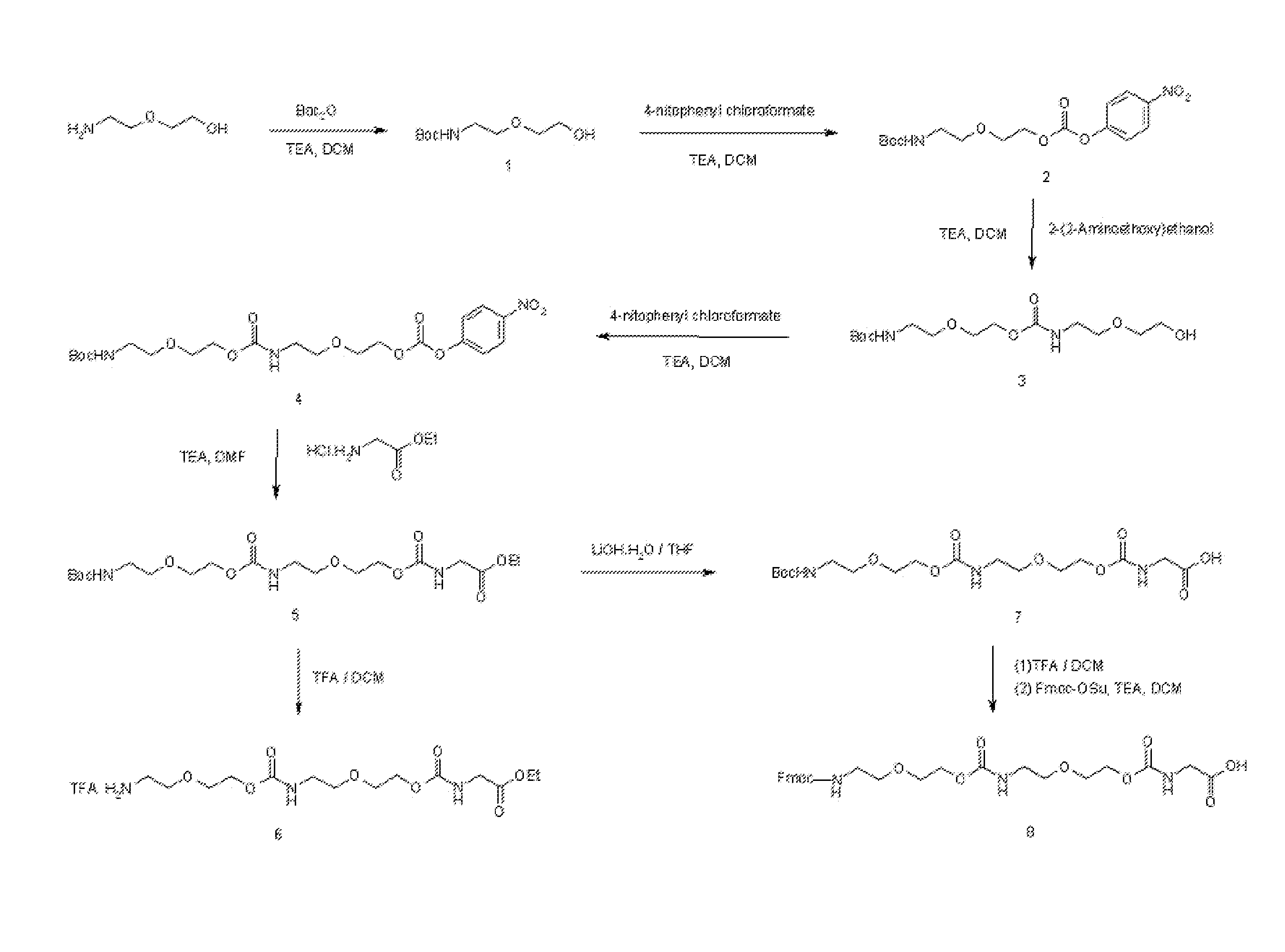Synthesis of peptide nucleic acids conjugated with amino acids and their application
a technology of peptide nucleic acids and amino acids, applied in the field of synthesis of peptide nucleic acids conjugated with amino acids and their application, can solve the problems of reducing the efficiency of hybridization, steric hindrance, and difficulty in detecting several sequences at once using fluorescent dyes of different colors, so as to improve the sensitivity and specificity of detection of a target gene, and improve the sensitivity and specificity. l synthesis of a synthesis of a synthesis of a synthesis of a synthesis of a synthesis of a synthesis of a synthesis of a synthesis of a synthesis of a synthesis of a technology of a synthesis of a synthesis of a synthesis of a technology of a synthesis of a synthesis of a technology of a synthesis of a technology of a synthesis of a technology of a synthesis of a synthesis of a synthesis of a synthesis of a synthesis of a synthesis of a synthesis of a synthesis of a synthesis of a synthesis of a synthesis of a synthesis of a synthesis rea s s s s s s s s s s s
- Summary
- Abstract
- Description
- Claims
- Application Information
AI Technical Summary
Benefits of technology
Problems solved by technology
Method used
Image
Examples
example 1
Synthesis of Long Linear Aamino Acid Monomer (Compound 8) [FIG. 3]
[0068]
[1-1] Synthesis of t-butyl 2-(2-hydroxyethoxy)ethyl carbamate (Compound 1)
[0069]2-(2-Aminoethoxy)ethanol (30 g, 0.28 mol) was dissolved in dichloromethane (500 mL). After sufficiently cooling in an ice bath, t-butoxycarbonyl (Boc) anhydride (82 g, 0.36 mol, 1.3 eq) was slowly added. After sufficiently cooling for 20 minutes, followed by addition of triethylamine (40 mL, 0.28 mol, 1 eq), the mixture was stirred at room temperature for 40 minutes. Then, the reaction mixture was washed with 1 N hydrochloric acid (HCl) aqueous solution (500 mL). The organic layer was dried with magnesium sulfate (MgSO4) and the solvent was removed. The target compound t-butyl 2-(2-hydroxyethoxy)ethyl carbamate (Compound 1) was yielded (56 g, 92%).
[0070]1H NMR (CDCl3) δ 1.44 (s, (CH3)3C—, 9H), 3.21 (q, J=5.2 Hz, —HNCH2CH2—, 2H), 3.53-3.60 (m, —CH2CH2OCH2—, —OCH2—, 4H), 3.69 (q, J=4.4 Hz, —CH2CH2OH, 2H), 4.69 (brs, —CH2OH, 1H), 5.9 (b...
example 2
Synthesis of Long Linear Amino Acid Monomer (Compound 12) [FIG. 4]
[0084]
[2-1] Synthesis of ethyl 38,38-dimethyl-4,12,20,28,36-pentaoxo-5,8,13,16,21,24,29,32,37-nonaoxa-3,11,19,27,65-pentaazanonatriacontan-1-oate (Compound 9)
[0085](2-{2-[2-(2-t-Butoxycarbonylaminoethoxy)ethoxycarbonylamino]ethoxy}ethoxycarbonylamino acetic acid ethyl ester (Compound 5, 13.2 g, 0.03 mol, 1 eq) was dissolved in dichloromethane (100 mL) and then stirred. After slowly adding trifluoroacetic acid (150 mL), the mixture was stirred at room temperature for 30 minutes. After removing the solvent, washing 2 times with diethyl ether followed by drying yielded trifluoroacetate of (2-{2-[2-(aminoethoxy)ethoxycarbonylamino]ethoxy}ethoxycarbonylamino)acetic acid ethyl ester (Compound 6, 14.3 g, 99.4%). The trifluoroacetate of (2-{2-[2-(aminoethoxy)ethoxycarbonylamino]ethoxy}ethoxycarbonylamino)acetic acid ethyl ester (Compound 6, 14.1 g, 0.029 mol, 1.5 eq) was dissolved in dichloromethane (200 mL). After sufficient...
example 3
Synthesis of Long Linear Amino Acid Monomer (Compound 15) [FIG. 5]
[0091]
[3-1] Synthesis of ethyl 54,54-dimethyl-4,12,20,28,36,44,52-heptaoxo-5,8,13,16,21,24,29,32,37,40,45,48,53-tridecaoxa-3,11,19,27,35,43,51-heptaazapentapentacontan-1-oate (Compound 13)
[0092]Ethyl 38,38-dimethyl-4,12,20,28,36-pentaoxo-5,8,13,16,21,24,29,32,37-nonaoxa-3,11,19,27,65-pentaazanonatriacontan-1-oate (Compound 9, 2.8 g, 0.0039 mol, 1 eq) was dissolved in dichloromethane (30 mL) and then stirred. After slowly adding trifluoroacetic acid (30 mL), the mixture was stirred at room temperature for 30 minutes. After removing the solvent, followed by washing 2 times with diethyl ether and drying, a trifluoroacetate of (2-(2-(2-(2-(2-(2-(2-(aminoethoxy)ethoxycarbonylamino)ethoxy)ethoxycarbonylamino)ethoxy)ethoxycarbonylamino)ethoxy)ethoxycarbonylamino)acetic acid ethyl ester (Compound 10, 3.0 g, 99.6%) was obtained. The trifluoroacetate of (2-(2-(2-(2-(2-(2-(2-(aminoethoxy)ethoxycarbonylamino)ethoxy)ethoxycarbonyl...
PUM
| Property | Measurement | Unit |
|---|---|---|
| humidity | aaaaa | aaaaa |
| structure | aaaaa | aaaaa |
| Chemical Formula | aaaaa | aaaaa |
Abstract
Description
Claims
Application Information
 Login to View More
Login to View More - R&D
- Intellectual Property
- Life Sciences
- Materials
- Tech Scout
- Unparalleled Data Quality
- Higher Quality Content
- 60% Fewer Hallucinations
Browse by: Latest US Patents, China's latest patents, Technical Efficacy Thesaurus, Application Domain, Technology Topic, Popular Technical Reports.
© 2025 PatSnap. All rights reserved.Legal|Privacy policy|Modern Slavery Act Transparency Statement|Sitemap|About US| Contact US: help@patsnap.com



